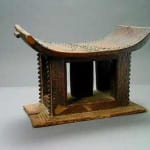Asante Stool with Metal Tacks, 20th Century CE
Wood and Tacks
14.375 x 9
PF.5940 (LSO)
Further images
This beautifully geometric stool was made by the Asante, one of the numerous tribes that make up the Akan polity of Ghana. It is a very ornate example, formed as...
This beautifully geometric stool was made by the Asante, one of the numerous tribes that make up the Akan polity of Ghana. It is a very ornate example, formed as a hollow rectangle with a central support, all holding up a flat platform seat with upwardly-flaring sides. The base is arranged as a multi-section pedestal, while the sides of the piece are decorated with incised decoration and irregular ribbing on the lateral aspects. The seat is further decorated with metal studs in a generally cruciform design in the centre of the seat, flaring out towards the sides. The wood is patinated with age and use. Stools such as this were used to assert status in many African tribal groups; only elites, and especially chiefs, were allowed to use them. Very often they were not sat upon, but were just displayed as regalia. This explains the often spindly and somewhat insubstantial construction of earlier examples.
The Akan are a loose assemblage of tribes – including the Akuapem, the Akyem, the Ashanti, the Baoulé, the Anyi, the Brong, the Fante and the Nzema – that share general cultural trends while maintaining separate tribal identities. Their society is highly ritualised, with numerous gods under a main deity who varies according to the group in question (Onyame – the Supreme One – is the Asante deity), and a host of lesser gods (Abosom) who are mostly connected with the natural world (earth, ocean, rivers, animals etc). The society is ruled by Asantahenes, and a host of minor chiefs who claim royal status through their connection with the land and the founders of villages upon it. One factor that unites the Akan is the fact that they took a golden stool as their emblem and rose up against the European invaders in the 18th century. They have also staved off interest from Northern Islamic groups. The main reason for this imperial interest was the long history of gold mining and gold working in the area, which has been taking place for at least 600 years.
This stool would have been treated with the same reverence that a throne might attract in western European groups, as it was literally that important. From an aesthetic point of view, it is a striking and attractive piece of secular art, and a worthy addition to any collection or sophisticated domestic setting.
The Akan are a loose assemblage of tribes – including the Akuapem, the Akyem, the Ashanti, the Baoulé, the Anyi, the Brong, the Fante and the Nzema – that share general cultural trends while maintaining separate tribal identities. Their society is highly ritualised, with numerous gods under a main deity who varies according to the group in question (Onyame – the Supreme One – is the Asante deity), and a host of lesser gods (Abosom) who are mostly connected with the natural world (earth, ocean, rivers, animals etc). The society is ruled by Asantahenes, and a host of minor chiefs who claim royal status through their connection with the land and the founders of villages upon it. One factor that unites the Akan is the fact that they took a golden stool as their emblem and rose up against the European invaders in the 18th century. They have also staved off interest from Northern Islamic groups. The main reason for this imperial interest was the long history of gold mining and gold working in the area, which has been taking place for at least 600 years.
This stool would have been treated with the same reverence that a throne might attract in western European groups, as it was literally that important. From an aesthetic point of view, it is a striking and attractive piece of secular art, and a worthy addition to any collection or sophisticated domestic setting.





